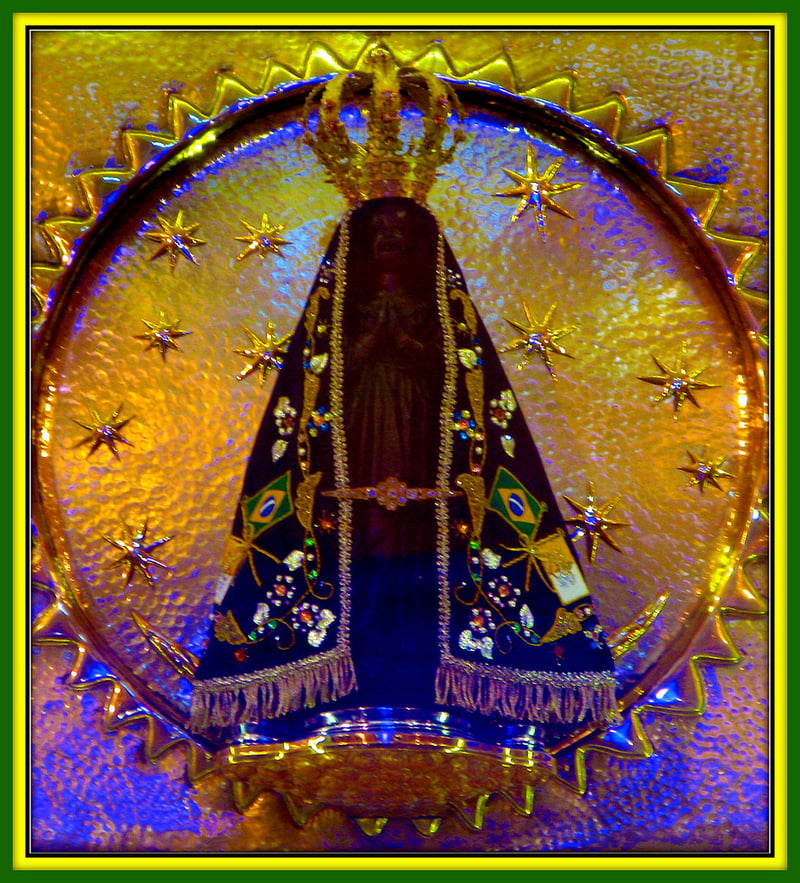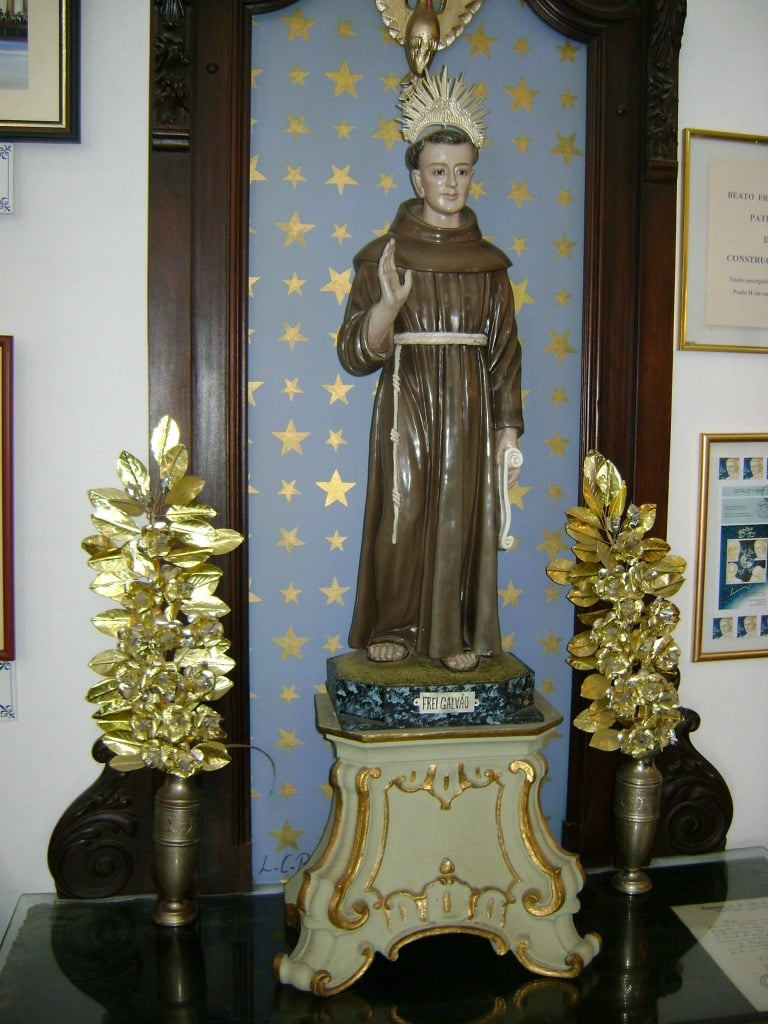Flávia Ghelardi writes from Brazil in English and Portuguese. Jump to the English version of this post.
Somos membros da Igreja Católica (que quer dizer universal), assim, em qualquer parte do mundo em que frequentarmos a missa, ouviremos as mesmas leituras e seguiremos o mesmo rito. A doutrina católica vale para todo o mundo e a tradição também. Porém, existem algumas peculiaridades de nossa fé que variam de acordo com a cultura de cada país. Como brasileira, gostaria de compartilhar com os leitores do CatholicMom algumas devoções do meu país.
O Brasil foi descoberto pelos portugueses no ano de 1.500. O motivo pelo qual Portugal iniciou as chamadas “grandes navegações”, foi para expandir a fé católica e os navegadores portugueses que aqui chegaram eram membros da Ordem de Cristo, uma sucessora dos Templários. O primeiro nome do Brasil foi “Terra de Santa Cruz” e o primeiro ato dos portugueses aqui foi a celebração de uma missa. Muitos religiosos, principalmente jesuítas, vieram nas primeiras décadas após o descobrimento, para trazer a boa nova do Evangelho. Assim, o Brasil já nasceu católico.
Nos últimos anos a população brasileira que se declarava católica caiu para cerca de 65%, mas ainda somos consideramos o maior país católico do mundo. Nossa padroeira é Nossa Senhora Aparecida (oficialmente reconhecida pela lei 6802/80), cuja festa comemoramos no dia 12 de outubro, feriado nacional. O Santuário de Nossa Senhora Aparecida é o maior santuário mariano do mundo e pode abrigar 43 mil pessoas de uma só vez.
Uma em cada 9 cidades brasileiras tem nome em honra a algum santo. A mais conhecida e a maior do Brasil é São Paulo. Temos também três estados com nomes de santo: São Paulo, Santa Catarina e Espírito Santo. Algumas festas católicas são feriados nacionais: Natal, Sexta Feira Santa, Corpus Christi, Nossa Senhora Aparecida (12/10), Finados (02/11), Mãe de Deus (01/01) e a Quarta Feira de Cinzas é ponto facultativo. Muitas cidades tem feriados locais no dia de seu padroeiro. Onde eu moro, em Campinas/SP, a padroeira é Nossa Senhora da Conceição, cuja festa celebramos no dia 8 de dezembro.
A segunda festa mais popular do Brasil (depois do Carnaval) são as festas juninas, em honra de três santos: Santo Antônio, São João Batista e São Pedro. Comemoramos o Dia dos Namorados em 12 de junho (acho que somos o único país no mundo que comemora em junho), pois é a véspera do dia de Santo Antônio, que é conhecido aqui como “santo casamenteiro”. O próprio Carnaval tem suas origens católicas, pois celebravam com fartura o último dia antes do início da quaresma, tempo de jejum e penitência.
O primeiro (e único) santo brasileiro até agora é Santo Antonio de Santana Galvão, que foi canonizado por Bento XVI no ano de 2007. No Mosteiro da Luz, em São Paulo, é possível conseguir as famosas “pílulas” para tomar e pedir uma graça. A história dessas pílulas é que, certo dia, um homem procurou Frei Galvão pois sua esposa estava em trabalho de parto, correndo risco de morrer. Frei Galvão escreveu em três papeizinhos o versículo do Ofício da Santíssima Virgem: Pos partum Virgo, Inviolata permansisti: Dei Genitrix intercede pro nobis (Depois do parto, ó Virgem, permaneceste intacta: Mãe de Deus, intercedei por nós). O homem levou a sua esposa, a mulher ingeriu os papeizinhos que haviam sido enrolados como se fossem pílulas e a criança nasceu sem problemas.
O milagre que canonizou Frei Galvão ocorreu em 1999, quando uma mulher que tinha uma grave má formação no útero e já tinha perdido três bebês, engravidou novamente e tomou as pílulas durante a gestação e, ao contrário do prognóstico médico, teve seu filho sem maiores problemas.
O povo brasileiro é um povo de fé e muito devoto, acostumado a fazer novenas, rezar o terço, fazer procissão em honra a diversos santos e também a rezar a via sacra. Isso se deve ao fato de que, desde o início da evangelização, como não havia muitos padres, nas vilas que iam surgindo, os próprios leigos fiéis, se encarregavam de expressar a fé católica através dessas práticas. E isso se mantém até os dias de hoje.
BRAZILIAN DEVOTIONS
We are members of the Catholic (that means universal) Church, so, in any part of the world that we attend Mass, we will hear the same readings and we will follow the same rituals. The Catholic doctrine is valid all over the world and so is Church tradition. However, there are some peculiarities of our faith that vary according to the culture of each country. As a Brazilian, I would like to share with CatholicMom readers some of my country's devotions.
The Portuguese discovered Brazil in the year of 1.500. The reason Portugal began the “Great Navigation” was to expand the Catholic faith. The Portuguese navigators who arrived here were members of the Order of Christ, a kind of successor from the Knights Templars. Brazil's first name was “Land of the Holy Cross” and the first act of the Portuguese here was the celebration of Mass. Many religious, especially the Jesuits, came in the first decades after Brazil's discovery to bring the Good News of the Gospel. This way, Brazil was born Catholic.
In recent years the Brazilian population who declared themselves Catholic dropped to around 75%, but we are still considered the largest Catholic country in the world. Our patroness is Our Lady of Aparecida (officially declared by the Law 6802/80), and we celebrate her feast on October 12th. The shrine of Our Lady of Aparecida is the largest Marian shrine in the world and can shelter 43 thousand people at once for a Mass.
One every 9 Brazilian cities is named after a saint. The most well-known, and the largest in Brazil, is São Paulo (Saint Paul). We also have three states named after saints: São Paulo (Saint Paul), Santa Catarina (Saint Catherine) and Espírito Santo (Holy Spirit). Some Catholic feasts are national holidays: Christmas, Good Friday, Corpus Christi, Our Lady of Aparecida (Oct 12th), All Souls (Nov 2nd), Mother of God (Jan 1st). Ash Wednesday is not an official holiday, but most people don't work that day. Many cities have local holidays on the day of their patron saint. Where I live, in Campinas/SP, the patroness is Our Lady of the Immaculate Conception, whose feast is celebrated on December 8th.
The second most popular feast in Brazil (after Carnival) are the June Festivals, in honor of three saints: Saint Anthony of Padua, Saint John the Baptist and Saint Peter. We celebrate Valentine's Day on June 12th (I think we are the only country in the world that celebrates it in June), because is the vesper of Saint Anthony's day, and Saint Anthony is known here as a “marriage maker” saint. Even Carnival has its Catholic origins, because they celebrate with abundance the last day before the beginning of Lent, a time of fast and penance.
[tweet "Catholic customs in #Brazil include unique #StAnthony celebration"]
The first (and only so far!) Brazilian saint is St. Antonio de Santana Galvão, canonized by Pope Benedict XVI in 2007. In the Monastery of the Light, in São Paulo, you can get the famous “pills” to take and ask for a grace. The history of those pills is that one day a man searched for Fr. Galvão because his wife was in labor, with her life and the child's in danger. Fr. Galvão wrote on three little papers one verse of the Office of the Most Holy Virgin: Pos partum Virgo, Inviolata permansisti: Dei Genitrix intercede pro nobis (After the labor, oh Virgin, you remained intact: Mother of God, intercede for us). The man took them to his wife, the woman swallowed the small papers that were wrapped as pills, and the child was born without further problems.
The miracle that led to Fr. Galvão's canonization happened in 1999, when a woman who had a severe malformation of her womb and had already lost three babies got pregnant again and took the pills during the pregnancy and, despite the poor medical prognosis, she had her baby without problems.
The Brazilian people are a people of faith and very devout, used to making novenas, praying the Rosary, going on processions in honor of many saints and also praying the Via Crucis. This is due to the fact that, since the beginning of our evangelization, there weren't many priests around, so in the villages that were emerging, the faithful lay were in charge of expressing the Catholic faith through those practices. And this has kept on until our days.
Copyright 2017 Flávia Ghelardi
About the Author

Flávia Ghelardi
Flávia Ghelardi is the mom of four, a former lawyer already "promoted" to full time mom. Flávia published her first book FORTALECENDO SUA FAMÍLIA and is a member of Schoenstatt´s Apostolic Movement. Flávia loves to speak about motherhood and the important role of women, as desired by God, for our society. She blogs at www.fortalecendosuafamilia.blogspot.com.




.png?width=1806&height=731&name=CatholicMom_hcfm_logo1_pos_871c_2728c%20(002).png)
Comments